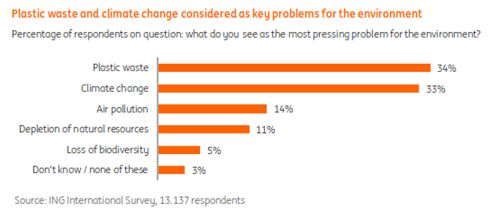Popular, problematic plastic
Over 8 million tonnes of plastic is used for food packaging in Europe, according to a new ING report. Consumers say it’s one of the most pressing environmental problems.

In Europe, packaging accounts for 60% of all plastic waste and the total amount of plastic packaging waste is growing by 2% each year.
Plastic seems indispensable, especially for food producers and supermarkets. Compared with other materials like cardboard, cans or glass, plastic is light, flexible and inexpensive. It contributes to food safety and shelf life, makes transport easier and is convenient for consumers.
But plastic packaging is also a source of environmental problems: it’s made from fossil fuels and it hardly decomposes when ending up as litter. In the eyes of European consumers, plastic waste is one of the most pressing environmental problems, according to a recent ING survey. They’re urging food and beverages producers and retailers to look for ways to reduce or improve their plastic packaging.
“People say they throw away an estimated three pieces of plastics waste daily, which makes it a very tangible problem they face every day,” explains Thijs Geijer, senior economist at ING.
In a new report, ING calculates that European companies use over 8 million tonnes of plastic to produce food and drink packaging. This is roughly the weight of 6 million new cars.
Six ways
ING’s research suggests six ways to tackle the problem:
- use lighter packaging, which requires less plastic
- use recycled material or omitting the packaging altogether
- improve recyclability by modifying the packaging and investing in the recycling system
- use bio-based and biodegradable plastic
- make more re-useable packaging
- switching to other materials such as cardboard, can or glass.
But one thing is clear: there is no one-solution-fits-all. Omitting packaging, for example, can lead to food waste, while bio-based plastic made from food crops requires more arable land. Cardboard, cans and glass also come with their own environmental challenges and therefore often mean transferring the problem.
“No single solution is sufficient on its own to remedy the plastic problem,” says Thijs. “We need a combination of multiple solutions and different areas of expertise to tackle the plastic puzzle in the food sector.”



